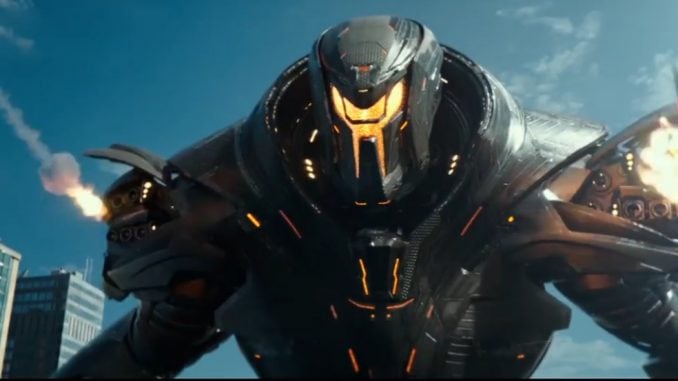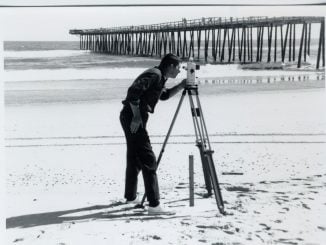
LOS ANGELES — Even if it hadn’t earned him dual Oscars, it’s easy to imagine why “The Shape of Water” struck Guillermo del Toro as a more enticing project than a sequel to “Pacific Rim.” Thanks to del Toro’s peerless gift for breathing life into slimy organisms and high-tech gadgetry, the rock-’em-sock-’em 2013 summer tentpole got the job done, but felt like the director’s least personal film to date.
Nonetheless, having grossed a respectable $101 million at home and an impressive $309 million abroad, “Pacific Rim” struck enough of a global chord to warrant a return engagement, and thus “Pacific Rim Uprising” arrives with del Toro (originally slated to direct, but instead advising in a producer’s capacity) handing over helming duties to Steven S. DeKnight, best known for his showrunner work on Netflix’s “Daredevil” and Starz’s “Spartacus.”
It’s a behind-the-scenes change that’s felt in ways both big and small, as this second entry in the franchise ditches, or downgrades, many of the elements that made del Toro’s original unique, while reconfiguring its style and attitude to more closely align with that of the “Transformers” films – a makeover that not only renders this follow-up unremarkable, but suggests (given the underwhelming box-office performance of Michael Bay’s last Hasbro-based effort) diminished long-term prospects with robot-fatigued audiences.
DeKnight’s desire to emulate Bay’s blockbuster template is apparent mere minutes into its action. Picking up a decade after its predecessor, which detailed humanity’s use of gigantic Jaegers (massive “mecha” robots manned by two psychically linked pilots) to fend off invading alternate-dimension “kaiju” (towering malevolent creatures), “Pacific Rim Uprising” opens with Jake Pentecost (Boyega) fleeing a shady business deal and, in search of coveted technological goods, meeting teenage orphan Amara (Cailee Spaeny), who’s built herself a Jaeger from spare parts. And not just any old Jaeger: Amara’s DIY creation is a beetle-y ‘bot that can be operated by a solo pilot, has the ability to roll itself into a ball, and is named Scrapper.
Jake, the wayward son of Idris Elba’s now-deceased commander Stacker, has long since abandoned his Jaeger-cockpit career for a life of partying and criminality. But his encounter with Amara, and their subsequent arrest for battling a real Jaeger, soon thrusts him back into the service, courtesy of his adopted sister Mako (Rinko Kikuchi), who still sees great potential in her younger sibling.
At the Pan Pacific Defense Force’s new Chinese headquarters (named, as before, Shatterdome!), Jake is reunited with former partner Nate Lambert (Scott Eastwood), whose gruff greeting implies that they didn’t part on good terms. Together, they’re tasked with mentoring a group of cadets (including Amara) to be Jaeger pilots. Fortunately, since the war against the kaiju was won, no further beasts have emerged from the inter-dimensional breach located in the Pacific Ocean (the whereabouts of Charlie Hunnam’s Raleigh Becket remain unknown).
Yet all is not well for these mature and adolescent heroes-to-be, since the Shao corporation — led by Mrs. Shao (Tian Jing) and her right-hand man Newt (Charlie Day), who’s gone from being a kaiju fanboy scientist to an R&D guy — is prepping a line of Jaeger drones that can be controlled remotely, thus making Jake and his buddies one small step away from obsolescence.
DeKnight establishes this premise with a swiftness that’s apt to give one whiplash — or to leave those unfamiliar with the first “Pacific Rim” struggling to keep up. At the same time, he paints in such broad, cliched brushstrokes that distinctive personality proves in short supply. Boyega has a natural roguish charm that suits the silly material, and despite being surrounded by more computer-generated chaos than any one actor could hope to survive, his charisma prevents Jake from becoming a dull narrative focus. The same, alas, can’t be said of Eastwood, who, with enough squinting, physically resembles his iconic father Clint, but is a wooden presence most comfortable operating in a single stern-and-handsome register.
For wisecracking eccentricity, the director and his three co-screenwriters (Emily Carmichael, Kira Snyder, T.S. Nowlin) mainly rely on the tepid bickering of Day’s Newt and Burn Gorman’s genius Herman. They also turn much of their attention to Amara and her pre-adult comrades, which makes this saga feel like “Pacific Rim: The Next Generation” — an impression that plagued the similar “Independence Day: Resurgence.” By the time these kids are asked to operate mankind’s final Jaegers in an all-out campaign to save the world, the film — already firmly rooted in childish fantasies about robots battling monsters — tips completely over into the sort of preposterous juvenalia more apt to provoke rolls of the eyes than gasps of wonder, be it from Western moviegoers or those in Asia, who are directly courted via the participation of the formidable Jing and her fellow supporting Chinese actors.
“Pacific Rim Uprising” delivers plentiful CG mayhem, first between rival Jaegers (thanks to a mysterious rogue sentinel), and then between Jaegers and a trio of kaijus with transformative skills of their own. What it lacks, though, is both del Toro’s trademark Lovecraftian imagery (all slick tentacles and dank subterranean locales) and the sense of thunderous heft that the Mexican auteur bestowed upon his titans.
Here, DeKnight, cinematographer Dan Mindel, and a host of digital artists conjure a bevy of gigantic set pieces marked by cartoony insubstantiality, with Jaegers boasting a swiftness and invulnerability that recalls Bay’s Autobots and Decepticons. The same holds true of the kaiju, including a final super-Godzilla-like behemoth, who get more well-lit screen time than they did in del Toro’s dark-and-rainy predecessor, and yet look far phonier and physically detached from their surroundings — a problem exacerbated by shoddy green-screen work on footage of urban pedestrians fleeing the fiends.
While Lorne Balfe’s score provides requisite bombast, what resounds loudest about “Pacific Rim Uprising” is its lack of adventurousness, to the point that it neuters its genre-splicing conceit’s weirdest ideas — such as the metaphysical “drift” that binds the minds of Jaeger pilots, which here serves as just a tossed-off means of dispensing expository backstory. At least DeKnight is shrewd enough to make one of his mortal characters the true harbinger of doom (albeit one with a sketchy motivation). In the end, however, that individual’s apocalyptic scheming is less distressing than the film’s paint-by-numbers approach to franchise construction, replete with a formulaic promise of future installments that, on the basis of this entry, feels mostly like wishful thinking.



